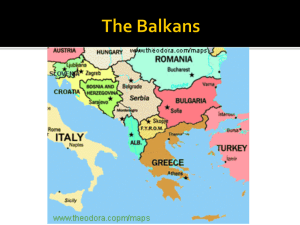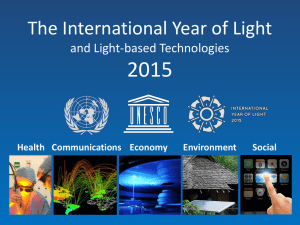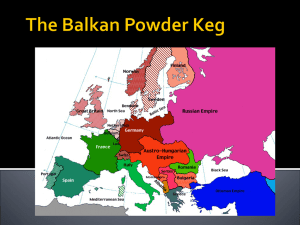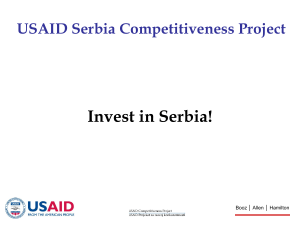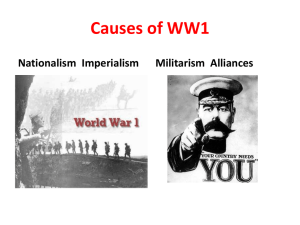A project funded by the European Union
advertisement
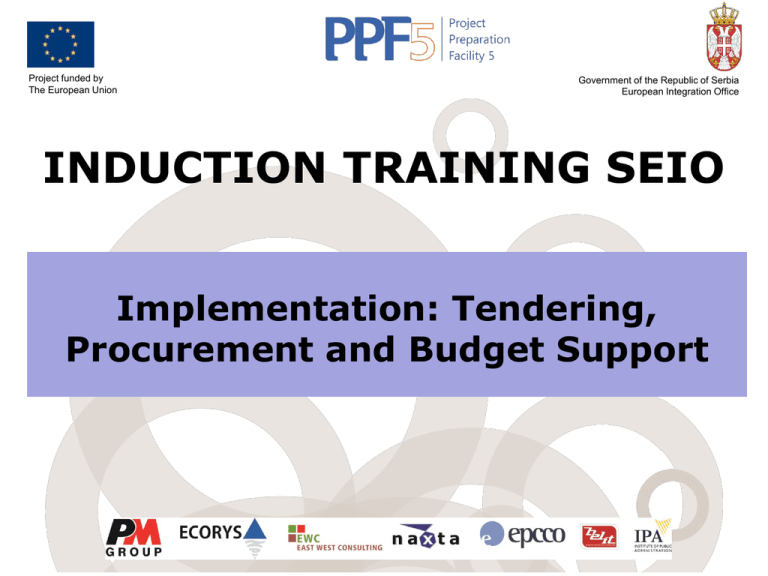
Project funded by The European Union Government of the Republic of Serbia European Integration Office INDUCTION TRAINING SEIO Implementation: Tendering, Procurement and Budget Support Training Objectives Overall the training will provide basic information on EU contracting procedures so that these can be taken into account when preparing implementation plans, sequencing and monitoring of future IPA Actions. Specifically, the training will explain: the PRAG and its relationship to the EU Financial Regulation; contract types and their uses; required documents for each contract type and procurement procedure contract value and its effect on procurement procedures time taken to complete the various procurement procedures and how to incorporate this into the development of realistic implementation plans requirements for budget support Project funded by The European Union Government of the Republic of Serbia European Integration Office Contracts Contracts are the normal legal basis for the disbursement of IPA finances (there are others e.g. Delegated Agreements, Sector Budget Support) In EU pre-accession funds a distinction is made between procurement contracts and grant contracts. In procurement, the clients requirements are specified in contract documents (e.g. Terms of Reference for consultants). By contrast, in grant schemes the client explains the problems and potential grant contractors make proposals to address these problems. The client chooses the best proposal and awards the grant i.e. The grant awardees design the solutions and not the clients (as in procurement). Project funded by The European Union Government of the Republic of Serbia European Integration Office PRAG Practical Guide to Contract Procedures for EU External Actions (PRAG) http://ec.europa.eu/europeaid/prag/document .do?locale=en Regulation No. 966 /2012 of the European Parliament and the Council on the Financial Rules applicable to the general budget of the Union Commission Delegated Regulation No. 1268/2012 of 29 October 2012 on the Rules of Application of Regulation No 966/2012 of the European Parliament and Council on the financial rules applicable to the general budget of the Union http://ec.europa.eu/budget/documents/financi al_regulation_en.htm Project funded by The European Union Government of the Republic of Serbia European Integration Office Types of Contract and Associated Documents IPA Action Document P r o c u r e m e n t SERVICES SUPPLIES Technical Specifications WORKS Bills of Quantity GRANTS Project funded by The European Union Terms of Reference Guidelines for Applicants Government of the Republic of Serbia European Integration Office Tendering Procedures SERVICES >€300,000 International restricted procedure < €300,000 but > €20,000 1.Framework contracts 2.Competitive negotiated procedure < €20,000 Single tender SUPPLIES > €300,000 International open procedure <€300,000 but > €100,000 Local open procedure <€100,000 but > €20,000 Competitive negotiated procedure < €20,000 Single tender >€5,000,000 1.International open procedure 2.International restricted procedure <€ 5,000,000 but > €300,000 Local open procedure < € 300,000 but > €20,000 Competitive negotiated procedure < €20,000 Single tender WORKS GRANTS Project funded by The European Union >€2,000,000 International call for proposals >€2,000,000 Local call for proposals For any amount in cases of urgency Direct grant Government of the Republic of Serbia European Integration Office Contracting Times Contract Type SERVICE SUPPLIES WORKS GRANTS Project funded by The European Union Procurement Procedure Average Time Taken International Restricted (9)-12 months Tender Framework (3)-5 months International Open Tender 9 months Local Open Tender 6 months International Open Tender 12+ months Local Open Tender 9-12 months International Call for 12+ months Proposals Local Call for Proposals (6)-9 months Government of the Republic of Serbia European Integration Office Service Contracts: International Restricted Tender Procedures Prepare ToR Negotiations with EC Publication of Procurement Notice Establish Sort List and prepare tender dossier Negotiations with EC Tender preparation /submission Tender evaluation, prepare Evaluation Report and contract dossier Negotiations with EC Contract Signature Project funded by The European Union Months 1 2 3 4 5 6 7 8 9 Government the Republic 10 of11 12 of Serbia European Integration Office Service Tender Dossier A. Instructions to the tenderers Letter of invitation to tender Instructions to tenderers B. Contract Contract, Special Conditions Terms of Reference Organisation and Methodologies Key Experts General Budget breakdown Conditions for service contracts C. Other information Shortlist notice Administrative compliance grid Evaluation grid D. Tender submission form Project funded by The European Union Government of the Republic of Serbia European Integration Office Supply Tender Dossier A. Instructions to the tenderers Letter of invitation to tender Instructions to tenderers b. Contract Contract Special conditions Annexes General conditions for supply contracts Technical specifications Budget breakdown Model for performance guarantee Model for advance guarantee C. Other information Glossary of terms Administrative compliance grid Evaluation grid D.Project Tender submission form funded by The European Union Government of the Republic of Serbia European Integration Office Works Contracts Works contracts cover construction, there are many national ‘standard’ forms of contract. Despite this, the EC have standardised on the use of an international contract format developed by the Federation Internationale des Ingenieurs-Conseils (FIDIC). It should be noted that IFIs (WB, EBRD) have their own standard documents which must be used by recipients. The most commonly used forms of contract available under FIDIC are: Conditions of Contract for Works of Civil Engineering Construction (The ‘Red Book’) Conditions of Contract for Design –Build and Turnkey (The ‘Orange Book’) Conditions of Contract for Electrical and Mechanical Works (The ‘Yellow Book’) Short Form of Contract (The ‘Short Form’). Project funded by The European Union Government of the Republic of Serbia European Integration Office Works Tender Dossier Most works contract dossiers contain the following documents: The Tender (Contractor’s offer) The General Conditions of Contract (FIDIC Part I) The Conditions of Particular Application (FIDIC Part II Clauses) The Technical Specifications The Design Documents (Drawings) The priced Bill of Quantities /Schedule of Rates Any other document forming part of the contract e.g. letters of clarification Project funded by The European Union Government of the Republic of Serbia European Integration Office Bills of Quantity (BoQ) An itemised list showing the number/ quantity of items required to complete the works, the units of measure, the rate per unit of quantity and the consequent total cost for that item. The BoQ may contain a number of bills classified by structure, trade, or standard method of measurement. In turn each bill will be broken down into separate items covering all elements of the works. The total number of items can be many hundreds. During construction the quantity of each item is remeasured and using the Contractors quoted unit rates, the value of the actual works completed by the Contractor is measured Project funded by The European Union Government of the Republic of Serbia European Integration Office Role of the ‘Engineer’ One of the main aims of Contractors, whilst making every effort to complete the works according to the contract, is to maximise profits wherever possible. This means the Contractor will interpret contract provisions to maximise advantage e.g. providing the cheapest materials to meet the minimum requirements in the specifications or by requesting frequent time extensions. Under FIDIC conditions an independent ‘Engineer’ must be appointed to supervise the works and to ensure that they are carried out according to the contract. The Engineer issues ‘Take Over’ and ‘Default Liability’ Certificates when the works are completed Project funded by The European Union Government of the Republic of Serbia European Integration Office Responsibilities of the Employer Ensure that the works are legally acceptable Appoint the Engineer Define the scope of the Engineer’s responsibilities Ensure that the site is freely available Provide for the Contractor's needs Pay the Contractor Consult with the Engineer on contractual obligations e.g. delays (time & cost to Contractor); rejection (cost to Employer); default of the Contractor (cost to Employer) before determining the amount due. Project funded by The European Union Government of the Republic of Serbia European Integration Office SPD: Implementation Planning SECTOR TITLE 2014 2015 2016 Q Q3 Q4 Q1 2 Q3 Q4 2017 2018 2019 2020 Q1 Q2 Q3 Q4 Q1 Q2 Q3 Q4 Q1 Q2 Q3 Q4 Q1 Q2 Q3 Q4 Q1 Q2 Q3 ACTION 1 Activity 1.1 Activity 1.2 P P C C C/I I I I I I I I I I I I P P C C I I I I I I I I I I I P P C C C C I I I I I I P C C C C/I I P P C C C C P P C C I I I I I I I I I I I I I I I I I I I I I I I I I I I I I I I I I I I I I I I I ….. ACTION 2 Activity 2.1 Activity 2.2 P P P P P = programming (period when the IPA action programme is expected to be adopted C = procurement and grant award procedure I = implementation period Project funded by The European Union Government of the Republic of Serbia European Integration Office Contracting & Disbursement Deadlines Deadline for concluding the Financing Agreement The final date for the signature of the Financing Agreement is X+1 (where X=year in which budgetary commitment was made). Conclusion of FA=year N Contracting deadline The end date for the signature of contracts (including grant contracts) is 3 years from the date of conclusion of the Financing Agreement i.e. N+3 Deadline for the execution of contracts The end date by which contracts (including grant contracts) must be finished is 3 years from the contract signature. The contracting deadline for the FA=N+3+3 Disbursement deadline The end date for making payments to contractors is 1 year after the deadline for executing contracts i.e. N+3+3+1 Final date for the implementation of the Financing Agreement The end date for closure of the Financing Agreement is 8 years. After this date no financial transactions can be made legally under the Financial Agreement concerned Project funded by The European Union Government of the Republic of Serbia European Integration Office Programme Intervention Logic Operations Collective rural projects Activities Results Reinforcement of rural producers Improved productivity Land consolidation Specific Objectives Increased revenues Modernisation and adaptation Improved farming tools Attraction of outside companies Industrial buildings for new companies Overall Objective Development of existing activities Jobs created & safeguarded Stopping rural exodus New activities (tourism) Better living conditions Restoration of the environment / rural landscape Project funded by The European Union Improved value of natural areas Better image of rural areas 18 Government of the Republic of Serbia European Integration Office Project funded by The European Union Government of the Republic of Serbia European Integration Office INDUCTION TRAINING SEIO Budget Support What is Budget Support (BS)? BS is a method of delivering financial assistance which normally has 4 steps: (Sector) Policy Dialogue Financial Transfers (in ‘tranches’) to National Treasury Account Performance Assessment Capacity Development BS is delivered by means of ‘Sector Reform Contracts’. Project funded by The European Union Government of the Republic of Serbia European Integration Office Political and Economic Focus of IPA-BS Compliance with the political criteria should be the primary focus of IPA2 BS. In particular, assistance should support preparations for acquis chapters 23 and 24 (The ‘Rule of Law’) For the economic criteria, the main focus of IPA2 BS should be on supporting the establishment of a functioning market economy (Copenhagen Criteria: i.e. ‘The ability to withstand the pressures of the internal market’) Project funded by The European Union Government of the Republic of Serbia European Integration Office Assessment of Eligibility Assessment takes place at 2 stages in the programme cycle. During programme preparation: assessment of relevance (are key constraints /weaknesses addressed?) and credibility (realism, institutional capacity, track record, political commitment) During programme implementation: assessment of progress made in policy implementation (benchmarked against reform commitments) Project funded by The European Union Government of the Republic of Serbia European Integration Office Risk Management Framework Risk management is an internal assessment of risk levels based on the analysis of replies to questionnaires in 5 categories, namely: 1. Political 2. Macroeconomic 3. Developmental 4. Public Financial Management 5. Corruption /Fraud There are 4 risk levels: Low Moderate Substantial High Beneficiaries are expected to define their risk response by means of ‘Mitigation Measures’ (these are monitored) Project funded by The European Union Government of the Republic of Serbia European Integration Office Whether to Provide BS? The EC decision on providing BS is based on 3 assessments: 1. Assessment of political commitment to a reform agenda (in line with EU accession) 2. Assessment of eligibility 3. Assessment of risks and mitigation measures Project funded by The European Union Government of the Republic of Serbia European Integration Office Variable Tranches: Performance Reserves ‘A Performance Monitoring System and related disbursement criteria is at the heart of any budget support operation’ (EC) BS disbursements are of 2 sorts: Base (or fixed) tranches: these are linked to eligibility criteria Variable tranches: these are intended to create an incentive for improved performance and are based on performance indicators. The EC limit (cap) the use of variable tranches to avoid unpredictability /volatility of disbursements. Typically, Sector Reform Contracts cover commitments for 3 years with an upper limit of 40% variable tranches Project funded by The European Union Government of the Republic of Serbia European Integration Office Variable Tranche (Performance) Indicators The following principles should be applied: 1. Targets and indicators should be Coherent with sector problem analysis and programme objectives 2. Whilst combined indicators may be used, the emphasis should be on Results 3. Number of indicators should be limited to a maximum of 8 per Tranche (to avoid loss of policy focus) 4. Indicators, targets and assessment methodology should be defined during programme preparation Project funded by The European Union Government of the Republic of Serbia European Integration Office Project funded by The European Union Government of the Republic of Serbia European Integration Office

